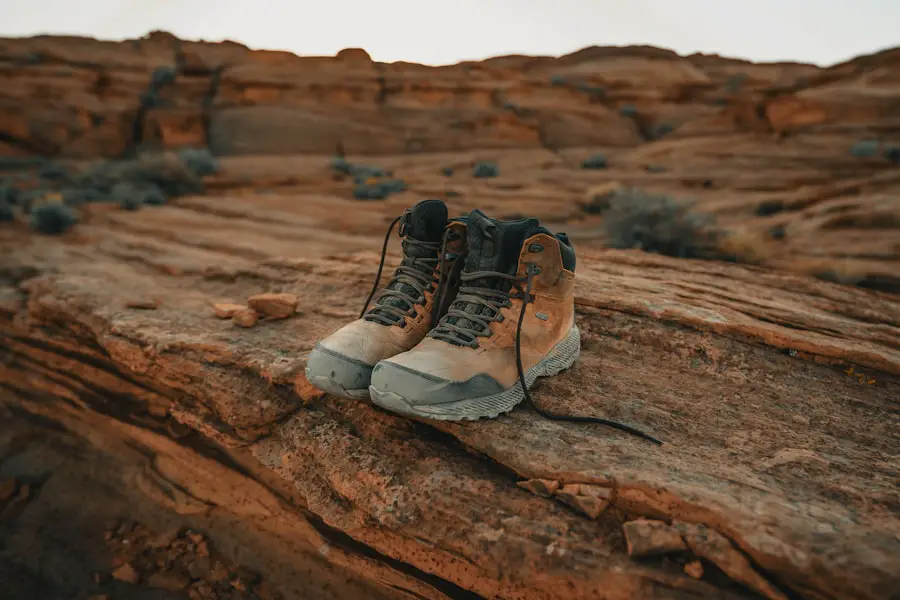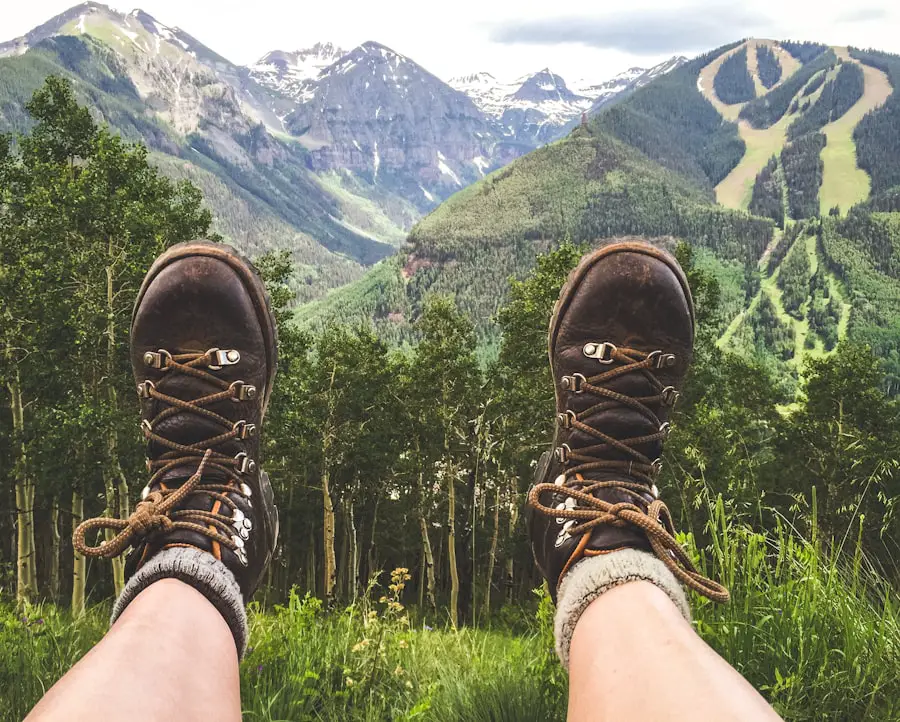Proper lacing of hiking boots is a fundamental aspect of ensuring comfort and performance on the trail. The way a boot is laced can significantly affect how it fits, how well it supports the foot, and how effectively it prevents injuries. When boots are laced correctly, they provide a snug fit that minimizes movement within the boot, reducing the risk of blisters and hot spots.
This snugness is crucial during long hikes, where even minor discomfort can escalate into significant pain over time. A well-laced boot allows for better control over foot placement, which is essential when navigating uneven terrain. Moreover, the importance of lacing extends beyond mere comfort; it also plays a vital role in enhancing overall foot and ankle stability.
Hiking often involves traversing rocky paths, steep inclines, and slippery surfaces, all of which require a secure fit to maintain balance and prevent falls. Proper lacing techniques can help distribute pressure evenly across the foot, reducing fatigue and allowing hikers to maintain their energy levels throughout their journey. In essence, mastering the art of boot lacing is not just about personal comfort; it is a critical skill that can enhance safety and performance in the great outdoors.
Key Takeaways
- Proper hiking boot lacing is important for preventing discomfort and injury on the trail.
- Different lacing techniques can provide better support, fit, and comfort for different foot types.
- Choosing the right lacing method for your foot type can prevent blisters and hot spots.
- Adjusting lacing for different terrains and conditions can improve traction and stability.
- Using lacing to improve ankle support can prevent sprains and strains on uneven terrain.
Understanding Different Lacing Techniques
There are several lacing techniques that hikers can employ to achieve the best fit for their boots. The most common method is the standard crisscross lacing, where the laces cross over each other as they ascend the boot. This technique provides a balanced fit and is suitable for most foot shapes.
However, variations exist that cater to specific needs. For instance, the “lock lacing” technique involves creating a loop at the top of the boot before tying it off. This method locks the heel in place, preventing it from lifting during descents, which can be particularly beneficial for those with narrow heels or those who frequently hike downhill.
Another popular technique is the “heel lock” or “lace lock,” which is particularly useful for individuals who experience heel slippage. By threading the lace through the top eyelet and then back down to create a loop, hikers can pull the lace tight and secure their heel in place.
Understanding these various techniques enables hikers to customize their lacing according to their specific needs and preferences.
Choosing the Right Lacing Method for Your Foot Type

Selecting the appropriate lacing method is crucial for accommodating different foot types. Individuals with wide feet may benefit from a more relaxed lacing style that allows for additional space in the toe box. A common approach for wide feet is to skip one or two eyelets at the bottom, which can alleviate pressure on the sides of the foot while still providing adequate support.
Conversely, those with narrow feet might find that a tighter lacing technique helps to secure their foot within the boot, preventing unnecessary movement that could lead to blisters. Additionally, individuals with high arches may require a different approach altogether. A technique known as “skip lacing” can be particularly effective for high-arched feet.
By skipping eyelets in specific areas, hikers can relieve pressure points and create a more comfortable fit. This method allows for better circulation and reduces the likelihood of developing hot spots during long hikes. Understanding one’s foot type and how it interacts with various lacing methods is essential for optimizing comfort and performance on the trail.
Tips for Preventing Blisters and Hot Spots
| Preventive Tips | Effectiveness |
|---|---|
| Choose the right footwear | Highly effective |
| Wear moisture-wicking socks | Effective |
| Use blister pads or bandages | Effective |
| Apply lubricants or powders | Effective |
| Keep feet dry and clean | Effective |
Blisters and hot spots are common issues faced by hikers, often resulting from friction between the foot and the boot. To prevent these painful nuisances, proper lacing is paramount. One effective strategy is to ensure that boots are neither too tight nor too loose; a snug fit will minimize movement while still allowing for some flexibility.
Additionally, using moisture-wicking socks can help keep feet dry, reducing friction and preventing blisters from forming. Another preventive measure involves paying attention to specific areas of the foot that are prone to blisters. For instance, if a hiker knows they typically develop blisters on their heels, they can adjust their lacing technique to provide extra support in that area.
This might involve using a heel lock or ensuring that the laces are tightened appropriately around the ankle. Furthermore, applying blister prevention products such as blister pads or specialized creams can provide an additional layer of protection against friction.
Adjusting Lacing for Different Terrains and Conditions
The terrain and conditions encountered during a hike can vary widely, necessitating adjustments in lacing techniques to ensure optimal performance. For example, when hiking on steep inclines or rocky paths, a tighter lacing method may be beneficial to provide additional support and prevent foot slippage within the boot. Conversely, when traversing flat or well-maintained trails, hikers might opt for a looser fit to enhance comfort and allow for greater flexibility.
Weather conditions also play a significant role in determining how boots should be laced. In wet or muddy conditions, ensuring that boots are tightly laced can help prevent debris from entering the boot and causing discomfort. On the other hand, during hot weather hikes, loosening the laces slightly can improve ventilation and reduce heat buildup inside the boot.
Being adaptable with lacing techniques based on terrain and weather conditions can significantly enhance a hiker’s experience.
Using Lacing to Improve Ankle Support

Ankle support is crucial for hikers, especially when navigating uneven terrain or carrying heavy packs. Proper lacing techniques can significantly enhance ankle stability by securing the boot around the ankle joint. One effective method is to lace up to the top eyelet and then use a heel lock technique to create additional tension around the ankle area.
This not only helps prevent ankle rolls but also provides a more secure fit that can enhance overall confidence while hiking.
For those who require extra support due to previous injuries or weak ankles, using additional lacing techniques such as “ankle wraps” can be beneficial. This involves wrapping the laces around the ankle in a figure-eight pattern before tying them off at the top.This method provides targeted support and helps stabilize the ankle joint during movement. By understanding how to use lacing effectively for ankle support, hikers can reduce their risk of injury and improve their overall hiking experience.
Troubleshooting Common Lacing Issues
Despite best efforts, hikers may encounter common lacing issues that can affect comfort and performance on the trail. One frequent problem is lace slippage, where laces come undone during hikes. To combat this issue, hikers can use lace locks or double knot their laces to ensure they stay secure throughout their journey.
Additionally, selecting high-quality laces made from materials that grip well can also help prevent slippage. Another common issue is uneven pressure distribution across the foot due to improper lacing techniques. If certain areas feel too tight while others are loose, it may be necessary to reassess the lacing pattern used.
Experimenting with different techniques or adjusting tension in specific areas can help achieve a more balanced fit. Hikers should also regularly check their boots during breaks to ensure that their laces remain properly adjusted throughout their hike.
Expert Tips for Mastering Hiking Boot Lacing
To truly master hiking boot lacing, it’s essential to practice different techniques before hitting the trail. Familiarizing oneself with various methods allows hikers to quickly adapt their approach based on personal comfort and specific trail conditions. Additionally, investing time in understanding one’s foot shape and any unique requirements will lead to better-fitting boots.
Another expert tip is to carry spare laces while hiking; this ensures that if a lace breaks or becomes damaged during a trek, hikers have a backup readily available. Furthermore, regularly inspecting boots for wear and tear can help identify potential issues before they become problematic on the trail. By incorporating these expert tips into their routine, hikers can enhance their overall experience and enjoy greater comfort and stability on their adventures in nature.
If you’re looking for more outdoor adventure tips, you might also be interested in learning how to choose the best travel guidebook for your next trip. A good guidebook can provide valuable information on hiking trails, local attractions, and more to enhance your travel experience. Check out this article for helpful tips on selecting the perfect guidebook for your next adventure.
FAQs
What are the best lacing techniques for hiking boots?
There are several lacing techniques that can be used for hiking boots, including the heel lock lacing, surgeon’s knot, and window lacing. Each technique serves a different purpose, such as providing extra ankle support or relieving pressure on the top of the foot.
How tight should hiking boot laces be?
Hiking boot laces should be snug, but not so tight that they restrict blood flow or cause discomfort. It’s important to find the right balance between support and comfort, as overly tight laces can lead to foot pain and blisters.
What type of laces are best for hiking boots?
Durable, moisture-resistant laces made of materials like nylon or polyester are best for hiking boots. These materials are less likely to stretch or break, and they can withstand the rigors of outdoor use.
How often should hiking boot laces be replaced?
Hiking boot laces should be replaced when they show signs of wear and tear, such as fraying or breaking. It’s a good idea to carry spare laces on hiking trips in case they need to be replaced on the trail.
Are there specific lacing techniques for different foot shapes?
Yes, there are lacing techniques that can accommodate different foot shapes and issues, such as high arches, wide feet, or heel slippage. Experimenting with different lacing techniques can help alleviate discomfort and improve the fit of hiking boots.
